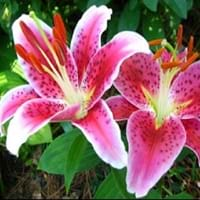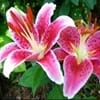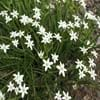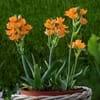Life Span
Perennial
Perennial
Type
Bulb or Corm or Tuber
Bulb or Corm or Tuber
Origin
Hybrid origin, North America, Europe, Africa, Asia
South America, Argentina
Types
Gloriosoides Baker Lily, Speciosum Lily
Not Available
Habitat
Not Available
Temperate Regions
USDA Hardiness Zone
2-8
5-9
Habit
Upright/Erect
Clump-Forming
Flower Color
White, Yellow, Red, Green, Purple, Gold, Pink, Rose, Peach, Burgundy, Bronze
Light Blue, Light Purple, Silver, Sky Blue
Flower Color Modifier
Bicolor
Bicolor
Fruit Color
Yellow green, Sandy Brown
Not Available
Leaf Color in Spring
Green, Dark Green
Green, Light Green, Gray Green
Leaf Color in Summer
Light Green
Light Green
Leaf Color in Fall
Several shades of Green
Several shades of Green
Leaf Color in Winter
Light Green
Light Green
Leaf Shape
Long Linear
Grass like
Plant Season
Spring, Summer, Fall
Spring
Sunlight
Full Sun, Partial Sun, Partial shade
Full Sun, Partial Sun, Partial shade
Growth Rate
Medium
Medium
Type of Soil
Clay, Loam, Sand
Clay, Loam, Sand
The pH of Soil
Acidic, Neutral, Alkaline
Acidic, Neutral, Alkaline
Soil Drainage
Well drained
Well drained
Bloom Time
Not Available
Early Spring, Spring, Late Winter
Tolerances
Drought
Drought
Where to Plant?
Container, Ground, Pot
Container, Ground
How to Plant?
Seedlings
By dividing rhizomes, tubers
Plant Maintenance
Medium
Medium
Watering Requirements
Needs more water during establishment, Use Mulches to help prevent water loss during hot and windy weather, Water daily during growing season
Average Water Needs, Do Not over Water, Requires regular watering
In Summer
Lots of watering
Lots of watering
In Spring
Moderate
Moderate
In Winter
Average Water
Average Water
Soil pH
Acidic, Neutral, Alkaline
Acidic, Neutral, Alkaline
Soil Type
Clay, Loam, Sand
Clay, Loam, Sand
Soil Drainage Capacity
Well drained
Well drained
Sun Exposure
Full Sun, Partial Sun, Partial shade
Full Sun, Partial Sun, Partial shade
Pruning
Prune in early spring, Prune in fall, Remove dead or diseased plant parts
Remove damaged leaves, Remove dead branches, Remove dead leaves
Fertilizers
All-Purpose Liquid Fertilizer, Compost, Fertilize only when soil is poor, slow-release fertilizers
All-Purpose Liquid Fertilizer
Pests and Diseases
Lily Beetle
Slugs, Snails
Plant Tolerance
Drought
Drought
Flower Petal Number
Single
Single
Foliage Texture
Not Available
Medium
Foliage Sheen
Not Available
Matte
Attracts
Not Available
Bees, Birds, Hummingbirds
Allergy
Not Available
Not Available
Aesthetic Uses
Beautification, Showy Purposes
Showy Purposes
Beauty Benefits
Making cosmetics, Skin cleanser
Not Available
Environmental Uses
Not Available
Air purification
Medicinal Uses
Acne, Burns, Heart problems
No Medicinal Use
Part of Plant Used
Whole plant
Flowers
Other Uses
Cosmetics, Oil is used for aromatherapy, Used As Food, Used as Ornamental plant
Not Available
Used As Indoor Plant
Yes
Yes
Used As Outdoor Plant
Yes
Yes
Garden Design
Alpine, Container, Cutflower, Feature Plant, Mixed Border, Wildflower
Container, Lawns and Turf, Mixed Border, Rock Garden / Wall, Wildflower
Botanical Name
Lilium speciosum
Ipheion uniflorum
Common Name
Japanese Lily
Spring Starflower, Springstar
In Hindi
जापानी लिली
Spring Starflower
In German
Pracht-Lilie
Frühling Borretsch
In French
Lily japonais
Spring Starflower
In Spanish
lirio japonés
primavera Flor de estrella
In Greek
Ιαπωνικά κρίνος
άνοιξη starflower
In Portuguese
lírio japonês
primavera Starflower
In Polish
japoński lilia
Wiosna Starflower
In Latin
lilium Italica
Spring Starflower
Phylum
Tracheobionta
Magnoliophyta
Class
Liliopsida
Lilopsida
Order
Liliales
Asparagales
Family
Liliaceae
Liliaceae
Clade
Angiosperms, Monocots
Angiosperms, Monocots
Tribe
Lilieae
Gilliesieae
Subfamily
Lilioideae
Allioideae
Number of Species
Not Available
Season and Care of Japanese Lily and Spring Starflower
Season and care of Japanese Lily and Spring Starflower is important to know. While considering everything about Japanese Lily and Spring Starflower Care, growing season is an essential factor. Japanese Lily season is Spring, Summer and Fall and Spring Starflower season is Spring, Summer and Fall. The type of soil for Japanese Lily is Clay, Loam, Sand and for Spring Starflower is Clay, Loam, Sand while the PH of soil for Japanese Lily is Acidic, Neutral, Alkaline and for Spring Starflower is Acidic, Neutral, Alkaline.
Japanese Lily and Spring Starflower Physical Information
Japanese Lily and Spring Starflower physical information is very important for comparison. Japanese Lily height is 30.00 cm and width 30.00 cm whereas Spring Starflower height is 10.20 cm and width 5.10 cm. The color specification of Japanese Lily and Spring Starflower are as follows:
Japanese Lily flower color: White, Yellow, Red, Green, Purple, Gold, Pink, Rose, Peach, Burgundy and Bronze
Japanese Lily leaf color: Green and Dark Green
Spring Starflower flower color: Light Blue, Light Purple, Silver and Sky Blue
- Spring Starflower leaf color: Green, Light Green and Gray Green
Care of Japanese Lily and Spring Starflower
Care of Japanese Lily and Spring Starflower include pruning, fertilizers, watering etc. Japanese Lily pruning is done Prune in early spring, Prune in fall and Remove dead or diseased plant parts and Spring Starflower pruning is done Remove damaged leaves, Remove dead branches and Remove dead leaves. In summer Japanese Lily needs Lots of watering and in winter, it needs Average Water. Whereas, in summer Spring Starflower needs Lots of watering and in winter, it needs Average Water.





